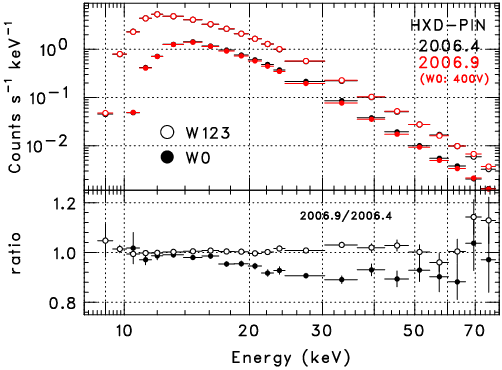Dear Suzaku users,
As noticed on the "HXD event log" page , on 2006 May 24, bias voltages for 16 out of 64 PIN diodes were reduced from 500 V to 400 V, to suppress the rapid increase of noise events, possibly caused by the in-orbit radiation damage. Since the thickness of depletion layer depends on the bias, this change slightly affected the energy response of the 16 PIN diodes especially at higher energy band than 20 keV. The comparison of Crab spectra obtained before and after the voltage reduction is shown below (see also the PDF version), in which filled circles (labeled "W0") indicate data from the 16 PIN diodes while open circles ("W123") denote spectra from other 48 diodes. While the effective area stayed almost the same below 15 keV, it decreased about 10% above 20 keV which corresponds to a few percent decline of the "total" effective area of HXD-PIN. In the current PIN response matrices (ver.20060814), this effect is not yet implemented. In addition, the level and shape of PIN-NXB are also expected to be different between two bias voltages, as a consequence of the loss of effective area. Therefore, especially in case of the faint source observations, the "standard" PIN analysis, which treat all the 64 diodes with no distinction, might draw an improper conclusion.

Until the calibration progress solves this situation, the HXD team temporarily recommend the observers to exclude data from the "diodes biased with 400 V", and to use the corresponding modified response matrices, together with the PIN-NXB event files for the W123-only analysis. A column named "UNITID" in the PIN event files is available to select the specified PIN diodes. There are 16 well-type phoswich units in the HXD and each of them consists of four PIN diodes, thus the UNITID ranges from 0 to 15, and the units biased with 400 V corresponds "UNITID=0,1,2,3". Therefore, the condition of "UNITID>3" should be applied with the "fselect" as follows (XXXX is your sequence ID):
unix% fselect aeXXXXhxd_0_pinno_cl.evt aeXXXXhxd_0_pinno_w123.evt 'UNITID>3'
Please note that you MUST NOT extract W123 data from "the background
for 64 PIN diodes", since the UNITID column is meaningless in the
background event files. Instead of extracting, you have to download
and use another background files from this page.
The current reproducibility of the PIN background is
described in this document (Suzaku memo 2006-42).
On 2006 October 3, another PIN high-voltage was also changed from 500 to 400 V, and the observational data after this date contain 32 PIN diodes biased with 400 V, and the other 32 diodes biased with 500 V. In these cases, the 'UNITID>7' condition should be applied, and the response matrices and background files for "W23-only analysis" should be used. The response matrices are listed in the same page as that of W123. The background files can be obtained from this page.